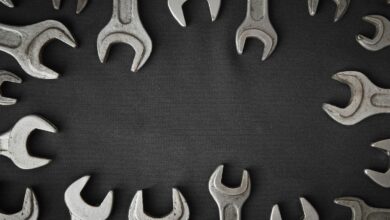Planning Your Shop’s Growth

You’re pouring money into tried and true marketing campaigns, asking your customers for online reviews, delivering incredible service and expanding your offerings. You’re doing all the same things that got you to where you are – a successful performance, restyling or restoration shop.
For a lot of us automotive enthusiasts, however, we’re never satisfied. We want more power, more cars, more followers, a bigger shop and a giant team. If you’ve reached a certain level of success, it’s easy to think that if you just keep doing what you’re doing, you’ll keep growing and building the business.
There comes a point in the growth of every shop (and really every growing business) where the owners have to make a transition. You have been hustling, jumping on opportunities whenever they arise and investing everything into the business. When things start to plateau, it can be tough to figure out what to do next.
So what’s the secret to finding new growth, clarity in your actions and continuing the momentum of building your business when you start to feel the plateau?
You may have made a business plan when you first started up. Now it’s time to make another. This time, your new growth business plan will encompass all of the learning, brand equity, experience and data that you’ve collected in building the business to its current state.
Considering your business will be continuously evolving and learning, we recommend you keep the time horizon of your new growth business plan short. At most, look out 12 months. As planning becomes more regular, you can bring this as low as three months.
Driven Performance Advisors works with shops at exactly this inflection point. We have watched this transition to new growth succeed and fail depending on the intentionality, discipline and clarity of the shop owners.
From our experience, here are our recommended components of your new growth business plan:
- Current state summary
- Strategic vision
- Product evolution
- People plan
- Sales forecast
- Marketing strategy
- Use of space
- Operational support
Current state summary
This section will summarize all the information you have about your shop and your business and can be further broken into subsections (not an exhaustive list):
- Products/services offered
- Team composition, skills at hand
- Roles and responsibilities
- Financial performance
- Marketing strategy
- Customer demographics
- Use of space
- Tools and technology
This summary takes stock of your capabilities and resources, as well as the current operating model of the business. All of it will evolve as you find and obtain new growth.
Strategic vision
We wrote about strategic visions in an early article for Driven Performance Advisors. The formula is simple. Describe your desired effect of your company on the future of the industry and structure the sentence in such a way that you can finish it with ‘which creates value for customers, owners, and the industry.”
Essentially, your strategic vision is the exact business structure that you want to create that maximizes your intended value for your customers, the business and the industry. The example I gave was a turbo manufacturer, whose strategic vision was: “one turbo, one engine, 10 seasons.”
This strategic vision will guide of all your additional business planning and decision making until you refresh just before you hit your next plateau.
Product evolution
As part of your strategic vision, do you need to add, remove, or change any of your offerings? Your plan for changes to your product offerings will help dictate the remaining planning items for your new growth business plan.
People plan
You know your strategic vision and you know how your products will evolve. That is enough information to make a plan for hiring and reallocation of roles and responsibilities.
Have your techs been responsible for pricing their jobs and dealing directly with customers? Perhaps now you’re adding in short-term maintenance work to supplement big restoration jobs that are waiting on parts. If your techs continue to work with customers on top of their work on the tools, there’s a high possibility they might not get a day’s work done. This means you’ll need to hire someone as a sales rep to work with customers exclusively. Then, think about what other administrative duties you’ve been handling that you can delegate to your techs that are more fixed in terms of time commitment.
Sales forecast
What do you predict your new growth business plan is going to do to your sales? Can you experience a 15% growth in the next 12 months instead of 5%? Will your new marketing strategy boost you up to 50% as you tap into a new segment of the market?
Your sales forecast is based on your historical financial data and provides you with a baseline for future cash flows, which will help you understand the resources you expect to gain over the next year.
Marketing strategy
Sponsorships and influencers? Instagram promotions? Hire an agency? Invest in the shop car and car shows (pandemic permitting…)? Win some races?
Depending on your sales forecast, product evolution and strategic vision, your marketing plan could take many different shapes. You will continue to learn what works and what doesn’t. At the end of the day, your marketing strategy is not a set of rules that you must follow, but the order in which you’ll try things and understand what works. Once you know what works, use it!
Use of space
Are you bursting at the seams in your current property? I know I’ve seen cars filling up shops and even being left outside on particularly busy days. Do you have lots of inventory that’s collecting dust, or disused machines? Or do you have no room for inventory that’s flying off the shelves or new equipment to enable your techs?
You ultimately have three initial choices when it comes to space. Move bigger, move smaller or optimize the current space.
If your strategic vision involves narrowing down your product offerings but increasing price and quality, you could benefit from a move smaller. If you’re expanding operations and offerings and other factors (lease expiring, rent increasing, etc.) are affecting your current property satisfaction, move bigger.
If you can afford to invest in your current space, this will be the least disruptive option. Add a mezzanine level, expand the building or simply clean up and rearrange to maximize the space.
Operational support
Will your tools, software, hardware, policies, processes, accountants and other operational support solutions be able to keep up with your new growth business plan?
Look at your current state summary and identify any deficiencies you have. Aim to grow into new solutions (pay for the more advanced shop management software) and build up robust and redundant processes and policies before they become necessary.
Misunderstandings with customers and employees are an Achilles Heel of many shops – prevent them as much as possible with clear communications, agreements, policies, and standard operating procedures that will make running your business simple.
—
The above activities can be simplified into a two-step process. Take stock of where you are and where you want to go, then create a plan to make it happen.
Specialty shop owners can be incredible visionaries and engineers who have successfully made their passion pay the bills. But it’s important to sometimes step out of that passion and really look at what will continue to make your business successful, so that the stress of day to day shop ownership doesn’t overwhelm the passion that got you into the business in the first place.
Take the time to create a new growth business plan and watch your shop continue to fulfill your dreams.



